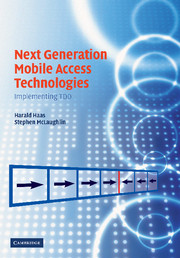Book contents
- Frontmatter
- Contents
- List of abbreviations
- Acknowledgements
- 1 Introduction
- 2 Wireless telecommunications using CDMA and TDD techniques
- 3 Interference and capacity analyses
- 4 Centralised DCA algorithm using the TS-opposing idea
- 5 Distributed DCA algorithm utilising the TS-opposing idea
- 6 UTRA-TDD Opportunity-Driven Multiple Access (ODMA)
- 7 Routing strategies in multi-hop CDMA networks
- 8 Multi-hop DCA
- 9 Radio resource metric estimation
- 10 Interference-based cancellation techniques for TDD
- 11 Smart Antennas for TDD-CDMA Systems
- 12 Cellular OFDMA-TDD
- 1 Derivation of T: Unconstrained Optimisation
- Bibliography
- Index
9 - Radio resource metric estimation
Published online by Cambridge University Press: 02 September 2009
- Frontmatter
- Contents
- List of abbreviations
- Acknowledgements
- 1 Introduction
- 2 Wireless telecommunications using CDMA and TDD techniques
- 3 Interference and capacity analyses
- 4 Centralised DCA algorithm using the TS-opposing idea
- 5 Distributed DCA algorithm utilising the TS-opposing idea
- 6 UTRA-TDD Opportunity-Driven Multiple Access (ODMA)
- 7 Routing strategies in multi-hop CDMA networks
- 8 Multi-hop DCA
- 9 Radio resource metric estimation
- 10 Interference-based cancellation techniques for TDD
- 11 Smart Antennas for TDD-CDMA Systems
- 12 Cellular OFDMA-TDD
- 1 Derivation of T: Unconstrained Optimisation
- Bibliography
- Index
Summary
Until now, the focus of the book has been on interference analysis and management for either a cellular TDD-CDMA system or an ODMA enhanced TDD-CDMA system. Interference management can be viewed as a form of resource management. In this chapter the issue of link adaptation is addressed with a focus on what metrics are appropriate to enable radio resource management in a cross-layer manner. In conventional systems, the decision on how to choose the ideal physical mode (PHY-mode) is primarily based on the knowledge of the interference encountered. This information is reported to higher-layer entities that deal with the radio resource management. Subsequently, the radio resource management entity makes a decision as to which physical resource will be used (e.g. by employing a DCA algorithms as described in Chapter 5 and 8) and this information is reported back to the physical layer. It is apparent that this process can take quite a long time. Meanwhile the channel conditions may have changed significantly. Hence, the previously chosen radio resource may no longer be the ideal choice. Therefore, new methods (e.g. resource metric estimation) are discussed here that (a) base the decision as to which radio resource to use, not only on interference, but also, for example, on the statistics of the channel state information, and (b) make the decision as to which radio resource to use already at the physical layer. For (a) it is shown that the TDD mode is ideally suited due to the reciprocity of the channel.
- Type
- Chapter
- Information
- Next Generation Mobile Access TechnologiesImplementing TDD, pp. 228 - 270Publisher: Cambridge University PressPrint publication year: 2008

